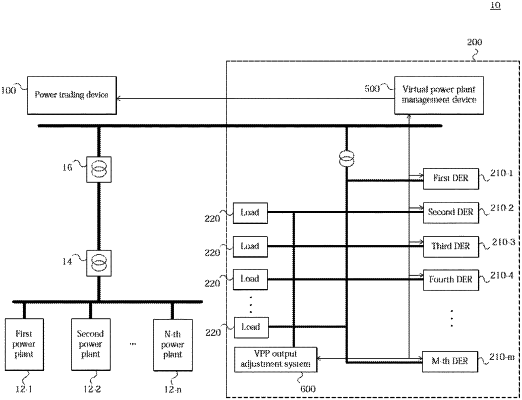| CPC H02J 3/008 (2013.01) [G06Q 50/06 (2013.01)] | 14 Claims |

|
1. A power trading system of virtual power plant (VPP), comprising:
a plurality of virtual power plants connected to a power system and including a distributed energy resource;
a heat conversion device connected to the power system and converting the power generated from the plurality of distributed energy resources into thermal energy, wherein the heat conversion device comprises a boiler or an electric heater connected to a heat storage tank and a heat pump, wherein the heat storage tank stores the thermal energy converted by the boiler or electric heater, wherein the heat pump supplies the stored thermal energy to a heat load; and
a power trading device comprising a processor and a memory storing instructions that, when executed by the processor, configure the power trading service to analyze an excess and insufficient power amount of the plurality of virtual power plant due to an output variation of the distributed energy resource, control power trading between the plurality of virtual power plant, the power system, or the heat conversion device by using the analysis result of the excess and insufficient power amount to stabilize the output of the power system and the virtual power plant,
wherein the power trading device is further configured to
monitor a VPP power generation amount by collecting real-time power generation data from the distributed energy resources,
derive a VPP expected output amount by subtracting a power consumption of loads in the virtual power plants from the monitored VPP power generation amount,
compare the derived VPP expected output amount with a VPP bidding power generation amount,
analyzes a response amount at which the distributed energy resources additionally generate power in order to respond to an output variation of a variable power source connected to the virtual power plant and a response rate at which the distributed energy resources additionally generate power in order to respond to an output variation of the variable power source, wherein the response rate comprises a ramp rate characteristic indicating a power generation rate change per minute, and
in response to power supplying in the virtual power plant being smaller than the power demand of load disposed in the virtual power plant due to the decrease in the output of the variable power source, and the response amount and the response rate of the distributed energy resources not meeting power demand amount of the load disposed in the virtual power plant, control the heat conversion device to reduce power consumption and increase a power trading amount from a renewable combined heat and power plant to the virtual power plant, wherein the renewable combined heat and power plant generates power using at least one of a wood chip, a fuel cell, or by-product gas.
|